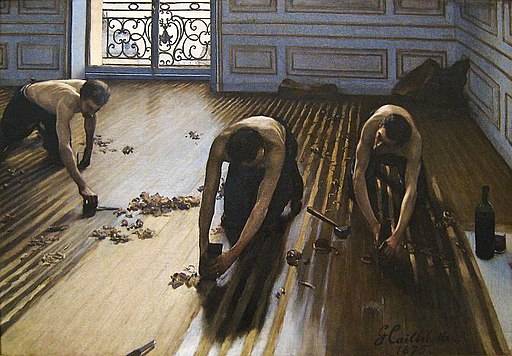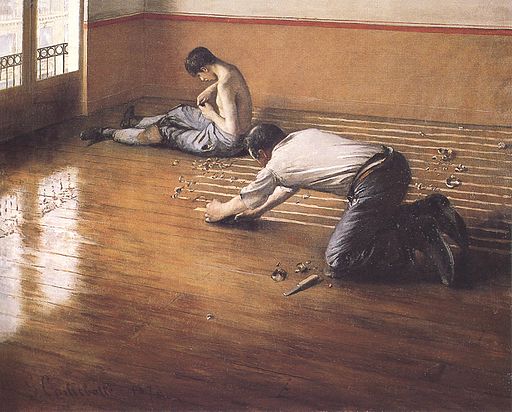For many years, I've admired this painting, Les Raboteurs de Parquet by Gustave Caillebotte.

Caillebotteraboteurs [Public domain], by Gustave Caillebotte (1848–1894) from Wikimedia Commons
The Wikipedia article tells us of a second painting of the same subject

Gustave Caillebotte-Floor-scrapers (1876) [Public domain], by Gustave Caillebotte (1848–1894) from Wikimedia Commons
To me, as well as being wonderful paintings, they are evidence that the surface of a floor used to be finished by planing.
The English language Wikipedia article refers to 'floor scrapers' but 'rabot' is French for plane; and in the first painting you can see the horn of a continental style plane between the fingers of the left hand of the chap on the right hand side. The shavings look like plane shavings and there is a hammer to adjust the cut. Ok, the guy in the middle is using a cabinet scraper, but there is definitely some planing going on.
Why am I digressing into art history like this? Well, it's all an introduction to my latest historical re-enactment. In order to re-discover what it's like, I have been planing a floor.
The floor in question is on our landing. We've ordered new carpet and I want it to last. One of the issues with the old carpet was that there were nasty edges on the boards, where there were gaps between them, and they made lines of premature wear on the carpet. It didn't help that the floor had been attacked by several generations of electricians and plumbers. Where central heating pipes run beneath, some boards were severely cupped.
So I have been down on my hands and knees putting it right. I have replaced one board, where before there were three little bits. I have punched down nails. I have sunk screws deeper. I have done dentist's work and extracted a tub full of little brads which once held Victorian lino. I have cut strips to fill gaps. And I have levelled the cupped, uneven boards by planing them.
I used a scrub plane to go across the grain:

and then an old smoother to clean up along the grain:

This smoother is one with a steel sole added by one of its many previous owners. It has already had a hard life and stands up to jobs like this well.

It has a "pre-loved" heavily cambered old iron

which survives encounters with the occasional invisible nail

Working up to the front of the airing cupboard provided a rare excuse to exploit the somewhat gimmicky chisel plane option on this Record 0130, but frankly a chisel would be just as good:

And here is the whole thing, just about finished:

To summarise, this is what I have learned, so you don't have to:
Has anyone else ever tried this? Would you try it? Or are you all sensible purchasers of flooring grade chipboard?

Caillebotteraboteurs [Public domain], by Gustave Caillebotte (1848–1894) from Wikimedia Commons
The Wikipedia article tells us of a second painting of the same subject

Gustave Caillebotte-Floor-scrapers (1876) [Public domain], by Gustave Caillebotte (1848–1894) from Wikimedia Commons
To me, as well as being wonderful paintings, they are evidence that the surface of a floor used to be finished by planing.
The English language Wikipedia article refers to 'floor scrapers' but 'rabot' is French for plane; and in the first painting you can see the horn of a continental style plane between the fingers of the left hand of the chap on the right hand side. The shavings look like plane shavings and there is a hammer to adjust the cut. Ok, the guy in the middle is using a cabinet scraper, but there is definitely some planing going on.
Why am I digressing into art history like this? Well, it's all an introduction to my latest historical re-enactment. In order to re-discover what it's like, I have been planing a floor.
The floor in question is on our landing. We've ordered new carpet and I want it to last. One of the issues with the old carpet was that there were nasty edges on the boards, where there were gaps between them, and they made lines of premature wear on the carpet. It didn't help that the floor had been attacked by several generations of electricians and plumbers. Where central heating pipes run beneath, some boards were severely cupped.
So I have been down on my hands and knees putting it right. I have replaced one board, where before there were three little bits. I have punched down nails. I have sunk screws deeper. I have done dentist's work and extracted a tub full of little brads which once held Victorian lino. I have cut strips to fill gaps. And I have levelled the cupped, uneven boards by planing them.
I used a scrub plane to go across the grain:

and then an old smoother to clean up along the grain:

This smoother is one with a steel sole added by one of its many previous owners. It has already had a hard life and stands up to jobs like this well.

It has a "pre-loved" heavily cambered old iron

which survives encounters with the occasional invisible nail

Working up to the front of the airing cupboard provided a rare excuse to exploit the somewhat gimmicky chisel plane option on this Record 0130, but frankly a chisel would be just as good:

And here is the whole thing, just about finished:

To summarise, this is what I have learned, so you don't have to:
- * Planing on your knees on the floor is best done by fit young Frenchmen, not middle-aged weaklings.
* Nineteenth century painters do not necessarily know all about woodwork.
* A bottle of wine per session is about right.
Has anyone else ever tried this? Would you try it? Or are you all sensible purchasers of flooring grade chipboard?









































